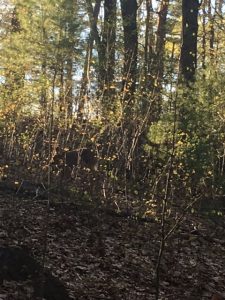I was walking to the golf course with a friend to complete a nature journal. We were walking from East Wheelock, and were just below the BEMA. A very light rustling caught my attention. Expecting a small squirrel, or perhaps a robin, I turned my head and looked into the forest. To my surprise, the light rustling was not caused by a small bird or rodent, but a rather large deer.
Although I had only recently seen the deer, I could tell the deer had been watching me for quite some time. The deer looked to be in a state of total alertness – its body was tense, its tail was slightly raised, and its ears were perked up. The deer was perhaps 5 feet long across and 4 feet high. It’s coat was darker than many of the deer I had seen, and was monocolored rather than freckled.
I almost didn’t notice the deer. The deer was almost the exact same color as the dull bronze leaves strewn across the forest floor, and its thin legs blended in with the narrow trees of the Bema. The deer’s patchy fur broke up its outline and made it blend in with the leaves.
After I got to the golf course, I sketched out the deer I had seen. I observed some crows, and several interesting pines, but nothing else of interest. Still, I thought I had pretty good luck for my nature journal – it’s not everyday you see a deer. When walking home, I decided to take a different route back. Rather than walk under the Bema, I decided to walk along the statue of Robert Frost and Bartlett Tower.
I decided to sit down next to my companion Robert Frost and saw another(!!) deer. This deer was even more elaborately camouflaged. I don’t think it was the same deer I saw earlier because it looked a good degree smaller, and was slightly darker. The light of the setting sun gave the deer freckled spots, and made the grove of trees glitter behind it. This deer was very difficult to see, and I only noticed it after it moved towards me.
This deer did not seem even mildly alarmed by my presence. It briefly looked at me, but as soon as I stopped walking, it put its head down and resumed eating. It was in a grove of young trees with uneven terrain, yet walked gracefully without making a sound. After observing it for some time (and taking lots of photos) I crossed the street and walked back towards my dorm.
Deer are all around us on the Dartmouth campus, but they are often very difficult to spot. They are quiet, blend in with the fall landscape, and like to rest behind shrubs and trees. The next time you go to the bema, be very mindful of your surroundings, and you’ll likely see one or more deer!
Have a good summer!
Leo






